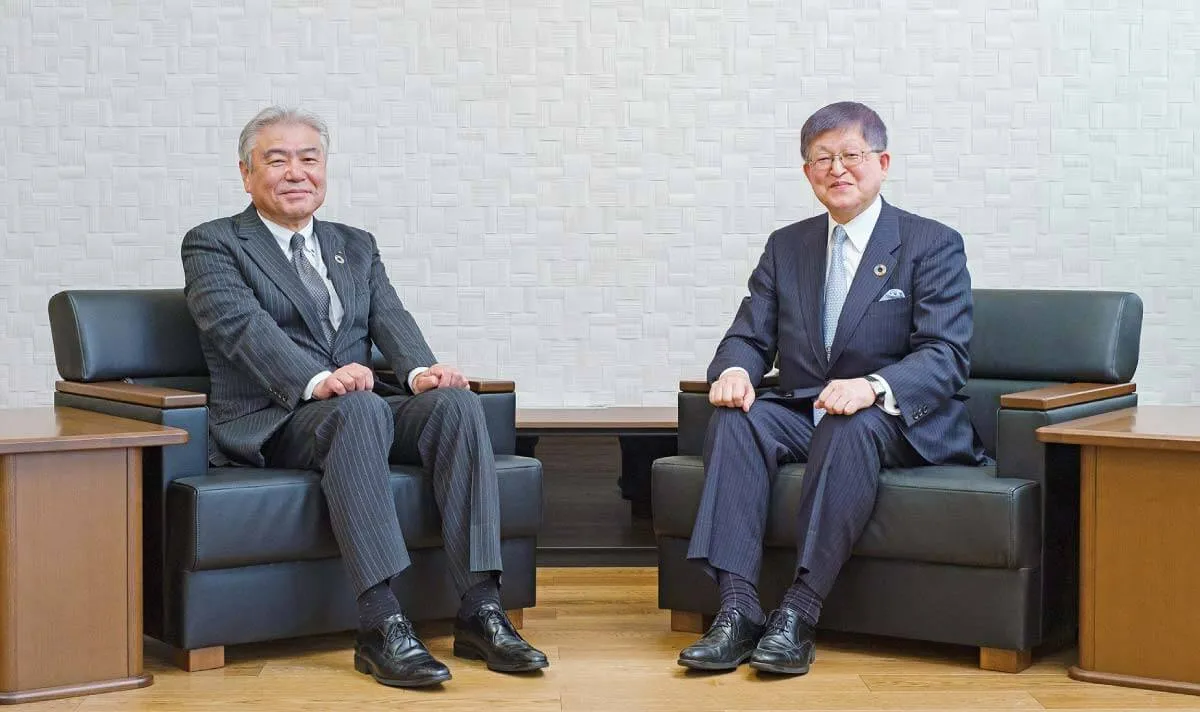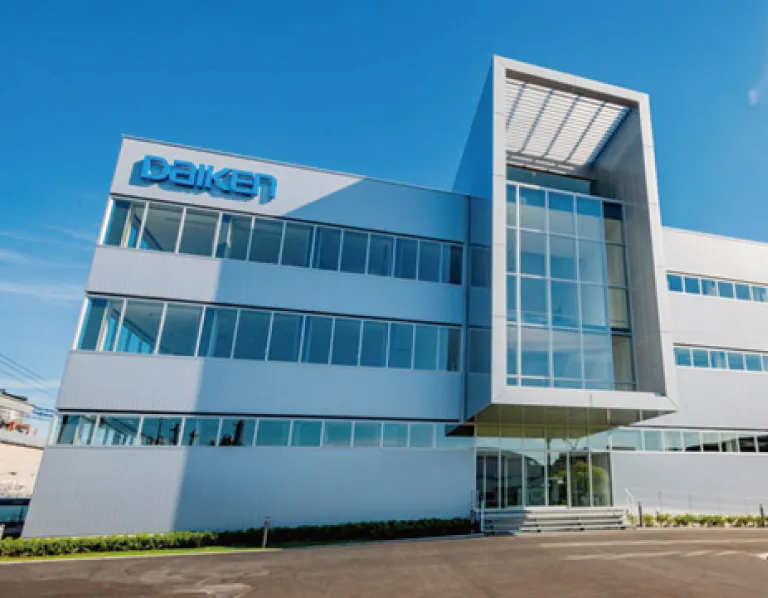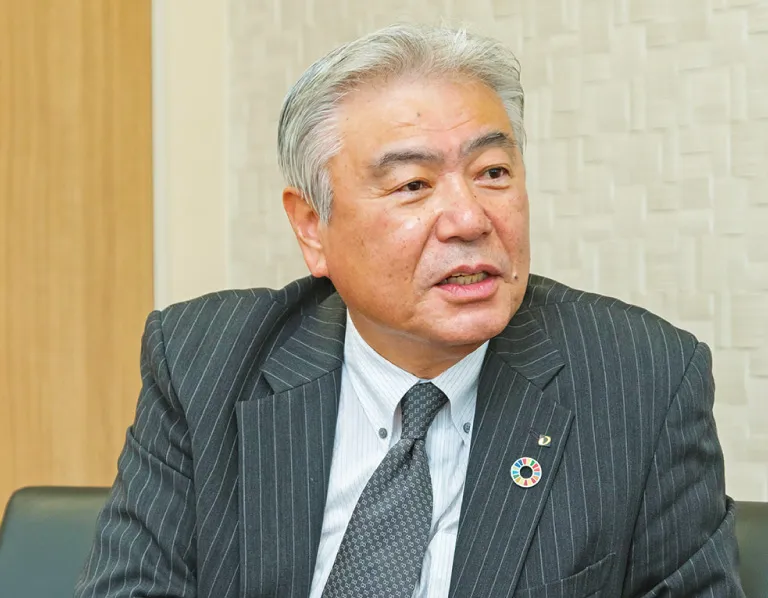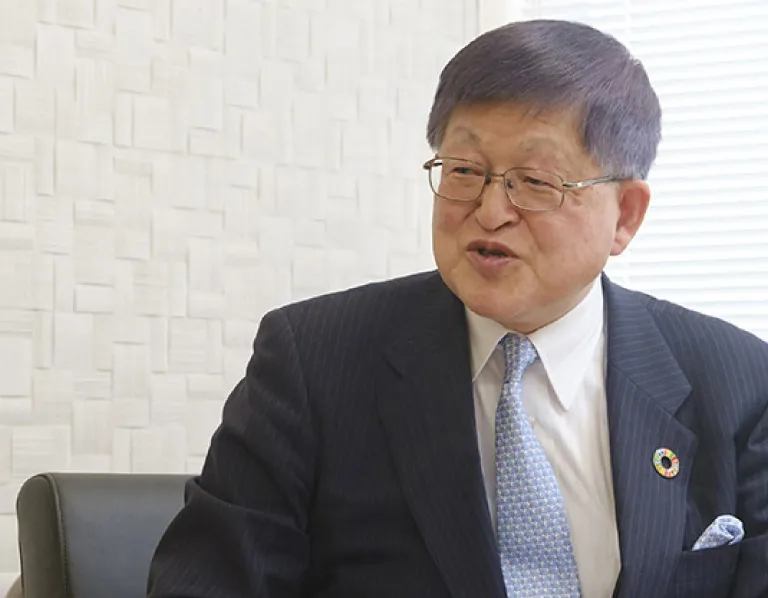Special Interview on SDGs:Pursuing New Value Creation by Leveraging SDGs

Representative director,
President
Masanori Okuda
Visiting Professor,
The Graduate School of Information
& Communication
Mr. Hidemitsu Sasaya
Since the adoption of SDGs by the United Nations in 2015, expectations have increased for contributions by companies through business activities for the resolution of social issues on a global scale, such as environmental problems. We invited Mr. Hidemitsu Sasaya (title omitted hereinafter), a consultant knowledgeable in SDGs, to the Daiken R&D center, our R&D facility that opened in October 2018, to speak with Masanori Okuda, our representative director, president, concerning future contributions to SDGs through business activities and how to turn such contributions into improvements in corporate value.
Special Interview
- Maintaining attitude to face social issues since foundation
- Leading innovations at the R&D center
- Establish a research environment and maximize the value of human resources
- Expand future-oriented business through development under SDGs
Maintaining attitude to face social issues since foundation
- Okuda:
- Our company was founded in Toyama in September 1945 soon after the end of World War II. The company started with the wood processing business in the hope of contributing to Japan's restoration from post-war devastation by using wood as a material to replace iron, which was in short supply in those days. Since our foundation, our goal was to use wood as a valuable resource without any waste. Through the effective use of scrap wood from demolished houses, and offcuts, we developed a technology that would create new added value. Therefore, I think our company has been pursuing SDGs since its origin without knowing it.
- Sasaya:
- SDGs consist of 17 global goals toward the realization of a sustainable world based on the analysis of global issues that have become increasingly more serious. These 17 goals are clearly the pursuit of respect for humans, protection of the global environ- ment, and other themes through partnerships. These goals were not generated suddenly but were crystallized as a summary of a long history. This process overlaps the long course that the DAIKEN CORPORATION has taken since its foundation during which the company has pursued the resolution of various social issues.
- Okuda:
- The first business that our company handled was plywood. We developed technology to improve water resistance and durability in order to use plywood in vehicles and vessels, and primarily handled special plywood that overcame the weakness of wood. Subsequently, in 1958, we established a plant for the use of unused resources in Okayama City, where this R&D center is located, for the expansion into new businesses. Wood fiberboard and Insulation boards (IB) that we produced here use scrap wood from demolished houses, and offcuts, thereby extending the carbon fixation period and contributing to the SDGs 17 “Responsible consumption and production” and the SDGs 13 “Climate action”. Our Dai-Lotone, which uses slag as a by-product from steel manufacturing also contributes to SDGs 12, while Dai-Lite, which uses the volcanic ash called Shirasu as a raw material, links to SDGs 11 “Sustainable cities and communities” because it contributes to quake-proof housing. In this way, many of our present businesses and products are linked to SDGs.
- Sasaya:
- The 17 SDGs were presented in a clear and orderly form to your company that originally had a SDGs-oriented attitude. A look at the relationship between the businesses of DAIKEN CORPORATION and SDGs will enable the recognition of its business value and provide stakeholders with an opportunity to learn of the potential of the company.
- Okuda:
- SDGs had yet to be defined when we started the individual businesses, but the concept of SDGs to contribute to the resolution of social issues toward sustainability seems to match our past initiatives and future goals. As stated in our group corporate philosophy: We will create a wonderful future with our technology, ideas, and passion, and As a company respected by everyone, we will give the highest priority to harmonizing an affluent society with the environment. This is why we must make continuous efforts to contribute to a sustainable society and enhance public trust. The recognition of SDGs clarifies the measures that our company should implement at present and into the future.
- Sasaya:
- It is natural that there are commonalities between SDGs and businesses that have been promoted under a social philosophy. DAIKEN CORPORATION may well be surprised that SDGs have not been defined much earlier.
Leading innovations at the R&D center
- Sasaya:
- While sustainability is extremely important in business, there is one more "S" that is critical: Scaling. Good practice needs to be expanded. In Japan, there is the idea of good for everyone, which urges that business should be good for the seller, good for the buyer, and good for the public. I propose a version of good for everyone, adding output to the concept above. Through outputs, partners who share the same idea gather, and their gathering leads to innovation. The R&D center is equipped with an exhibition space under the concept of open innovation, which presents outputs concerning your products and technological power.
- Okuda:
- When the R&D center first opened, experts were invited from universities across Japan to tour the inside of the facilities. In the coming years, we plan to invite students and dispatch our research- ers to universities, thereby deepening exchanges and leading to technological innovation that will create new value through industry- administration-academia collaborations.
- Sasaya:
- Okayama City, where the R&D center is located, has been selected as one of the SDGs Future Cities, which promote initia- tives for the attainment of SDGs. Interested persons frequently visit the city from other countries. The high technology of the DAIKEN CORPORATION will be recognized by such people through promo- tional measures. I believe that the DAIKEN CORPORATION has es- tablished an environment for leading to open innovations through the increased output power.

- Okuda:
- In terms of innovation, we expect R&D and business activities to indicate specific resolutions to be developed toward the goals specified in the SDGs. I hope that the R&D and business departments will identify goals toward which our company can exercise its strengths, think outside the box, and pursue development with a challenging spirit. Development personnel are encouraged to leverage SDGs in diverse ways, such as presenting ideas for development, sharing visions with partners, and examining the sustainability of business models.
Establish a research environment and maximize the value of human resources
- Sasaya:
- Through what you said, I recognized that DAIKEN CORPORATION has further motivated technological development personnel by establishing the R&D environment in the R&D center. In the center, I found a board on which each researcher of the center stated their future ideals. It is wonderful that you are proceeding toward the future with a participatory approach that enhances motivation. The efficient use of human resources is essential for fully exercising technological expertise and for creating business models with high added value. It will require an environment that is pleasant to work in as well as proper governance. I hope that you will continue to establish a suitable infrastructure.
- Okuda:
- I also believe that human resources are at the center of in- novative movements leveraging SDGs. I urge employees to deepen their ties to society, absorb a wide variety of knowledge, and promote development that will facilitate social participation. We established the R&D center, provided an environment, and defined milestones. The development team is moving toward those milestones. I expect that they will maintain a challenging spirit to move further ahead without dwelling on these checkpoints.

- Sasaya:
- I consider DAIKEN CORPORATION to have high human resource power. I hope that you will emphasize the process in which you, President Okuda, will visualize your philosophy, formulate the flow for value creation, and disseminate it to individual departments. According to the latest survey, SDGs have been disseminated to 60% of corporate management executives but only to about 20% of middle managers and employees. SDGs will become the mainstream of society. I hope that the president will share direct messages so that the understanding of SDGs will be further deepened throughout the DAIKEN CORPORATION.
- Okuda:
- Business activities are promoted by humans not by anything else. Our company invests in humans and endeavors to maximize human resource value. I believe that contribution to the resolution of social issues by the company will lead to improved corporate value.
- Sasaya:
- Partnerships for the goals and the spirit of harmonization as represented by SDGs 17 will enable people to connect to diverse issues and enhance their motivation for work.
- Okuda:
- I strongly hope that all employees recognize such partnerships and that we can proceed hand in hand.
Expand future-oriented business through development under SDGs
- Sasaya:
- DAIKEN CORPORATION has already been linked to social issues through SDGs. I suppose that you have come to the stage where you should consider how to enhance such links. In the ongoing process of global expansion, it is recommended to effectively leverage SDGs for visualization. Because SDGs are a common global language, they will facilitate the sharing of your vision with global partners. You will be more easily accepted as a company that proactively leverages SDGs.
- Okuda:
- Regarding global expansion, we have two plants in New Zealand that manufacture wood fiberboard MDF. We will examine how limited local wood resources can be leveraged. The longer wood is used in the form of wood fiberboard without burning, the more extended the carbon fixation period will become. Therefore, I believe that the expansion of this business will contribute to the prevention of global warming. We will further expand such wood material businesses overseas.
- Sasaya:
- The technological power that DAIKEN CORPORATION has accumulated over its long history, as well as its business models for industries of high added value based on that technological power, will definitely be accepted throughout the world. The Tokyo Olympics and Paralympics are drawing near. Sustainability is particularly emphasized in these SDGs-oriented Olympics/Paralympics, and sustainability is required for energy sources and materials to be used. Interest in SDGs will substantially rise among the general public. Along with the Osaka, Kansai Expo 2025, it will become a good opportunity to advertise business expansion linked to SDGs through such international events.

- Okuda:
- While SDGs are set for 2030, I do not regard it as the year of the goal. Our company will celebrate its 80th anniversary in 2025, when the Osaka, Kansai Expo 2025 will be held. We will also target at the 100th anniversary beyond that. We must envision our goal to- ward those major milestones. Strategies for the next stage of devel- opment are required, while the market environment has substantially changed with new housing starts on a declining trend in Japan. At present, our focus is on the expansion from industrial materials to building materials. When we are headed toward a new market, we should return to industrial materials as our starting point and continu- ously face social issues and needs in the new era. It is also possible that a substantially different business will become our core business further shifting away from building materials.
- Sasaya:
- DAIKEN CORPORATION has the power of technological innovation to create new products based on its accumulated technology. Its corporate message, Toward the future going beyond the functions of yesterday, represents your power of technological innovation. This phrase is amphibious, meaning both history up until yesterday and enhanced functions.
Leading social issues up until yesterday toward resolution with new functions - SDGs and DAIKEN CORPORATION share the same future-oriented approach. - Okuda:
- As an example of a specific initiative for the future, we are promoting the development of culture soil by applying wood processing technology. This initiative is aimed at replacing culture soil for plants with wood chips as a material for wood fiberboard. If such a material can be used for greening infertile deserts, it will contribute to SDGs 2, “Zero hunger”. If, for another example, Japanese paper used for the surface of tatami mats can be processed for other purposes, it will lead to deplasticization and may contribute to SDGs 14 “Life below water”.
- Sasaya:
- SDGs have leverage points that will lead to the resolution of more than one issue. In the case of DAIKEN CORPORATION, SDGs 9 “Industry, Innovation, and Infrastructure” and SDGs 17 “Partnerships for the goals” will be its leverage points. Innovations led under SDGs 9 will be linked to solutions to various goals and will be extensively distributed through partnerships under SDGs 17. In this way, I hope that DAIKEN CORPORATION will increasingly be- come an all-embracing company for building materials on a global basis.
- Okuda:
- I believe that SDGs will become the very themes of development in coming years. It depends on the ideas and enthusiasm of individual members of the group, including me at the top, executive officers, heads of departments, and employees, how those social issues and needs can be identified and leveraged. We would like to further deepen the existing technologies, promote development activities that will contribute to society, and enhance our corporate value through the resolution of social issues.
Thank you for time.

